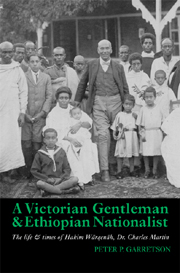 A Victorian Gentleman and Ethiopian Nationalist
A Victorian Gentleman and Ethiopian Nationalist Book contents
- Frontmatter
- Contents
- List of Illustrations
- Transliteration
- Note on the Ethiopian Calendar
- Glossary
- Acknowledgements
- Map 1 Ethiopia 1900–1950
- Map 2 Burma 1898–1919
- Introduction
- 1 Youth & education
- 2 Return to Ethiopia (1896–1901)
- 3 Campaigning in the Ogaden & return to Burma (1901–1907)
- 4 Transitions in life
- 5 A man of substance in Ethiopia & Burma
- 6 Return of a progressive to Addis Ababa (1919–1924)
- 7 An increased pace of modernization (1924–1930)
- 8 International diplomacy, education & recruitment
- 9 Governor of a model province, Chärchär (1930–1935)
- 10 Ethiopian ambassador to the Court of St. James (1935–1936)
- 11 London & India
- 12 Ethiopia
- Conclusion
- Bibliography
- Index
7 - An increased pace of modernization (1924–1930)
Published online by Cambridge University Press: 05 April 2013
- Frontmatter
- Contents
- List of Illustrations
- Transliteration
- Note on the Ethiopian Calendar
- Glossary
- Acknowledgements
- Map 1 Ethiopia 1900–1950
- Map 2 Burma 1898–1919
- Introduction
- 1 Youth & education
- 2 Return to Ethiopia (1896–1901)
- 3 Campaigning in the Ogaden & return to Burma (1901–1907)
- 4 Transitions in life
- 5 A man of substance in Ethiopia & Burma
- 6 Return of a progressive to Addis Ababa (1919–1924)
- 7 An increased pace of modernization (1924–1930)
- 8 International diplomacy, education & recruitment
- 9 Governor of a model province, Chärchär (1930–1935)
- 10 Ethiopian ambassador to the Court of St. James (1935–1936)
- 11 London & India
- 12 Ethiopia
- Conclusion
- Bibliography
- Index
Summary
After Wärqenäh's return from his trip with Regent Täfäri to England, he played a larger and more important role in the modernization of Ethiopia and was clearly much closer to the Regent as an increasingly trusted advisor and administrator. Qätsälä was also much closer to Wäyzäro Mänän after they had been on pilgrimage to Jerusalem in 1923. Täfäri entrusted Wärqenäh with more than seven significant modernizing tasks. These were: first, as principal of Täfäri Mäkonnen School (1925); second, as a founder and the leading member of the Feqrenna Agälgelot Mahbär (Love and Service Association) in 1926 and its school for slaves; third, as financial director of Berhanenna Sälam Press (1926); fourth as publisher of his World Geography, fifth as ‘supervisor’ for building a road from Addis Ababa to Jimma, sixth as President of the Special Court of Ethiopia in 1928 (sometimes known as the Mixed Court) and finally as co-holder of a platinum and gold concession in Wällägga. These jobs were added to his continuing and onerous responsibilities (especially in overseeing all their financial affairs) as Director of the Fel Weha Baths and also of the Bét Sayda Hospital. Most of these responsibilities would come to an end with his appointment in late 1930 as Governor of Chärchär province in Harar. However, he still continued to spend a large amount of time, before and after his Chärchär appointment, advising Täfäri on foreign and domestic matters, caring for his own large family and also carrying on increasingly extensive business affairs.
- Type
- Chapter
- Information
- A Victorian Gentleman and Ethiopian NationalistThe Life and Times of Hakim Wärqenäh, Dr. Charles Martin, pp. 124 - 152Publisher: Boydell & BrewerPrint publication year: 2012
